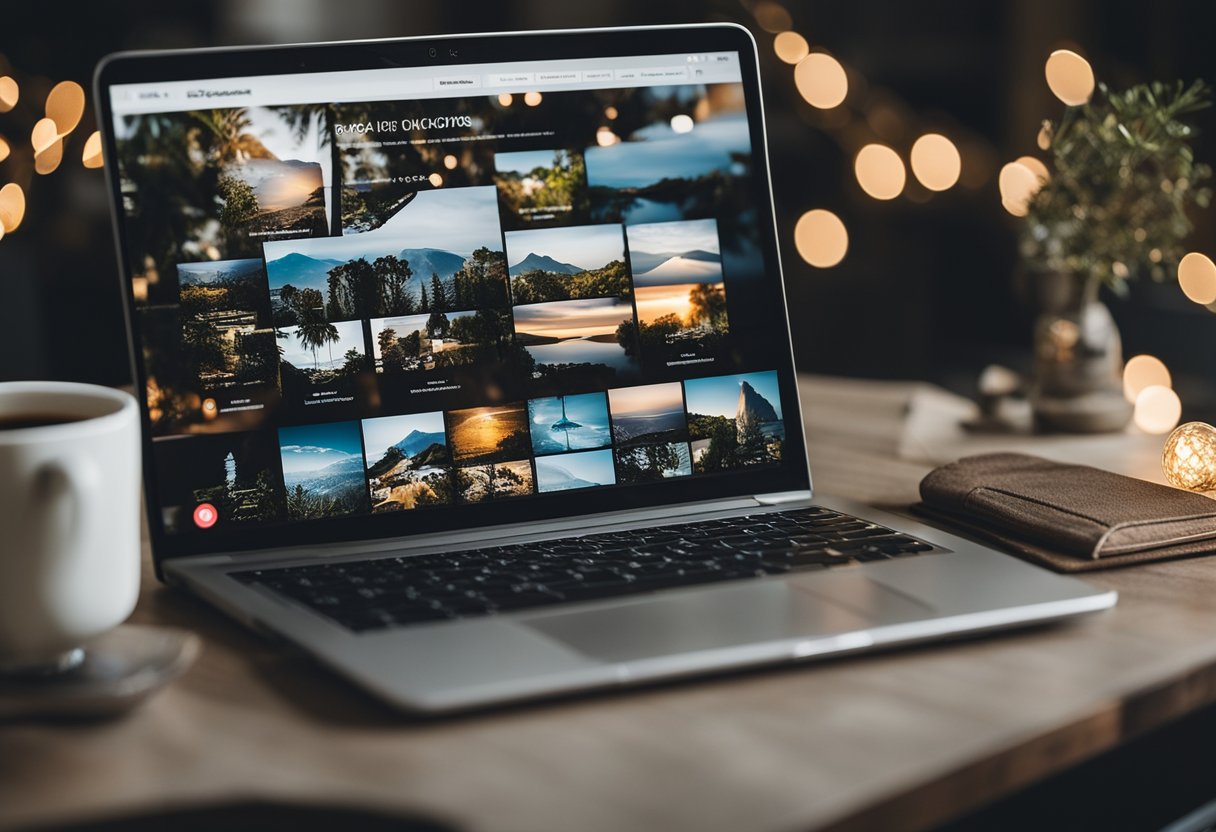Pinterest Domination: Crush Your Competition with These Top-Secret Techniques!”
Pinterest is a social media platform that allows users to discover and share ideas through images and videos. It has become a popular tool for bloggers to drive traffic to their websites and increase their audience. In this article, we will explore how to use Pinterest for blogging and provide tips on how to optimize your account and content to get the most out of this platform.
Understanding Pinterest is crucial to using it effectively for blogging. Pinterest is not just a social media platform, but also a search engine. Users search for ideas and inspiration using keywords, and Pinterest returns results based on relevance and quality. To use Pinterest effectively, bloggers need to create content that is visually appealing and optimized for search.
Setting up your Pinterest account is the first step to using Pinterest for blogging. Bloggers should create a business account, which provides access to analytics and other features that are not available on personal accounts. Once the account is set up, bloggers should optimize their profile and create boards that are aligned with their blog’s niche.
Key Takeaways
- Pinterest is a search engine and social media platform that bloggers can use to drive traffic to their websites.
- To use Pinterest effectively, bloggers need to create visually appealing content that is optimized for search.
- Bloggers should create a business account, optimize their profile, and create niche-specific boards to get the most out of Pinterest.
Understanding Pinterest
Pinterest is a visual search engine that allows users to discover and save ideas for different topics such as recipes, fashion, home decor, and more. It is a platform that can be used for personal or business purposes, including promoting your blog.
One of the main features of Pinterest is the use of pins, which are images or videos that can be saved to boards. Boards are like virtual bulletin boards that allow users to organize their pins by topic or theme. This feature makes it easy for users to find and save content that they are interested in.
Pinterest is also a social platform, allowing users to engage with others by following their boards, liking and commenting on pins, and sharing content. This social aspect of Pinterest can be used to build a community around your blog and increase engagement with your audience.
To use Pinterest for blogging, it is important to understand how the platform works and how to optimize your content for maximum visibility. This includes creating visually appealing pins, using keywords and hashtags to improve searchability, and engaging with the Pinterest community.
Overall, Pinterest is a powerful tool for bloggers to promote their content and grow their audience. By understanding how the platform works and utilizing its features effectively, bloggers can increase traffic to their website and engage with their audience in a meaningful way.
Setting Up Your Pinterest Account
To use Pinterest for blogging, you need to set up a Pinterest account. Here are the steps to set up your Pinterest account:
- Go to Pinterest.com and click on the “Sign Up” button.
- Enter your email address, password, and age, then click “Sign Up”.
- Select your language and location, then click “Next”.
- Choose topics that interest you, then click “Follow”.
- Enter your blog’s name and website URL, then click “Create Account”.
Once you have created your account, you need to optimize your profile. Here are some tips to optimize your Pinterest profile:
- Use a professional profile picture that represents your brand.
- Write a clear and concise bio that explains who you are and what your blog is about.
- Include your blog’s URL in your profile.
- Verify your website to get access to Pinterest Analytics.
- Create boards that are relevant to your blog’s niche and add pins to those boards.
By optimizing your profile, you can attract more followers and drive more traffic to your blog.
Creating a Pinterest Board
Pinterest boards are the foundation of your Pinterest account. They are where you organize your pins and showcase your content. In this section, we will discuss how to create a Pinterest board for your blog.
Choosing a Board Name
When creating a Pinterest board, it is essential to choose a board name that accurately represents the content you will be pinning. The board name should be clear, concise, and easy to remember. It should also include relevant keywords to help with search engine optimization (SEO).
For example, if your blog is about healthy recipes, you may want to create a board called “Healthy Recipes” or “Clean Eating Recipes.” These board names clearly convey the content of the board and include relevant keywords
Adding a Board Description
Adding a board description is an essential step in creating a Pinterest board. The board description should be a brief summary of the content that will be pinned to the board. It should also include relevant keywords to help with SEO.
For example, if your board is about healthy recipes, your board description may read, “Discover delicious and healthy recipes that are perfect for clean eating and weight loss. From breakfast to dinner, this board has it all!”
In conclusion, creating a Pinterest board is a crucial step in using Pinterest for blogging. By choosing a clear and concise board name and adding a board description that includes relevant keywords, you can increase the visibility of your content and drive traffic to your blog.
Creating and Pinning Blog Content
Pinterest is an excellent platform to promote your blog and drive traffic to it. To use Pinterest effectively, you need to create visually appealing pins that grab the user’s attention and lead them to your blog. In this section, we will discuss how to create and pin blog content on Pinterest.
Creating Pins
When creating pins for your blog content, you need to keep in mind that Pinterest is a visual platform. Therefore, your pins should be visually appealing and high-quality. Here are some tips for creating pins:
- Use high-quality images that are relevant to your blog post.
- Add text overlays to your pins to make them more informative and eye-catching.
- Use colors that are consistent with your brand.
- Make sure your pins are easy to read and understand.
Pinning Blog Posts
Once you have created your pins, it’s time to pin your blog posts. Here are some tips for pinning blog posts:
- Create multiple pins for each blog post. This will increase the chances of your content being seen by users.
- Pin your content at optimal times. According to research, the best times to pin are during the evening and on weekends.
- Use keywords in your pin descriptions and titles. This will help your content show up in search results.
- Join group boards related to your niche. This will increase the visibility of your content and help you reach a wider audience.
Overall, creating and pinning blog content on Pinterest takes time and effort, but it can be a great way to promote your blog and drive traffic to it. By following these tips, you can create visually appealing pins and pin your content effectively.
Utilizing SEO on Pinterest
Pinterest is a visual search engine that can drive traffic to your blog. Therefore, optimizing your content for search engines is crucial to increase your visibility on Pinterest. Here are some tips to help you utilize SEO on Pinterest.
Keyword Research
Before creating content for Pinterest, it is important to conduct keyword research. This will help you understand what your audience is searching for and what keywords to include in your pins and boards. You can use tools like Google Keyword Planner, Pinterest Trends, and Pinterest Analytics to find relevant keywords.
When conducting keyword research, focus on long-tail keywords that are specific to your niche. For example, if you have a food blog, instead of using broad keywords like “food,” use more specific keywords like “healthy dinner recipes” or “vegan desserts.”
Optimizing Pin Descriptions
Once you have your keywords, it is important to optimize your pin descriptions. Pin descriptions should be clear, concise, and include relevant keywords. When writing pin descriptions, think about what your audience is searching for and what information they need to know about your content.
In addition to including keywords, you can also use hashtags in your pin descriptions. Hashtags help your pins appear in relevant search results and can increase your visibility on Pinterest. However, it is important to use hashtags sparingly and only include relevant hashtags.
When optimizing your pin descriptions, also make sure to include a call-to-action. This can be as simple as asking your audience to save or click on your pin.
In conclusion, utilizing SEO on Pinterest is key to increasing your visibility and driving traffic to your blog. By conducting keyword research and optimizing your pin descriptions, you can improve your chances of appearing in relevant search results and reaching your target audience.
Engaging with the Pinterest Community

Pinterest is all about community, and engaging with other users is a key part of building a successful presence on the platform. Here are some ways to get involved and start interacting with the Pinterest community.
Joining Group Boards
One of the best ways to get your content in front of more people on Pinterest is to join group boards. These are boards that are curated by multiple users, and they can be a great way to reach a wider audience and get more engagement on your pins.
To find group boards to join, start by searching for keywords related to your niche. Look for boards that have a lot of followers and engagement, as these are likely to be high-quality boards that will benefit your content. You can also use tools like PinGroupie to search for group boards by category or keyword.
Once you’ve found a group board that you’re interested in joining, check the board description to see if the owner has any specific instructions for joining. Some boards require you to follow the owner or another collaborator before you can join, while others may require you to email the owner or fill out a form.
Interacting with Other Pins
Another important part of engaging with the Pinterest community is interacting with other users’ pins. This can help you build relationships with other bloggers and influencers in your niche, and it can also help you get more exposure for your own content.
To interact with other pins, start by searching for keywords related to your niche and looking for pins that are relevant to your interests. When you find a pin that you like, take a moment to like it, comment on it, or even repin it to one of your own boards.
You can also use Pinterest’s messaging feature to reach out to other users and start building relationships. Just be sure to keep your messages professional and focused on building a genuine connection, rather than just promoting your own content.
By joining group boards and interacting with other pins, you can start building a strong presence on Pinterest and growing your audience. Just remember to stay authentic and engage with the community in a genuine way, rather than just trying to promote your own content at every opportunity.




